Related Research Articles
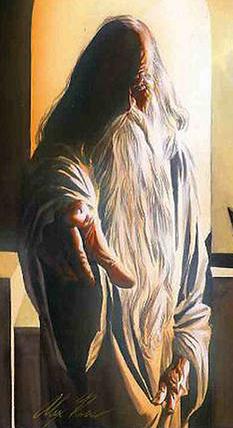
Shazam, often referred to as simply The Wizard, is a character appearing in American comic books published by both Fawcett Comics and DC Comics. He is not to be confused with his champion Shazam/Captain Marvel, the former bestowing powers on the latter as detailed in the 1940s Whiz Comics. In more modern stories, however, after DC officially changed Captain Marvel's name to "Shazam" in 2012, the characters now sharing the name as part of a legacy hero archetype.
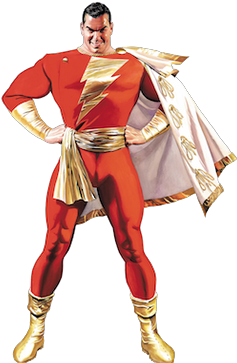
Captain Marvel, also known as Shazam and the Captain, is a superhero in American comic books originally published by Fawcett Comics and currently published by DC Comics. Artist C. C. Beck and writer Bill Parker created the character in 1939. Captain Marvel first appeared in Whiz Comics #2, published by Fawcett Comics. He is the alter ego of Billy Batson, a boy who, by speaking the magic word "Shazam!", can transform himself into a costumed adult with the powers of superhuman strength, speed, flight, and other abilities. The character battles an extensive rogues' gallery, most of them working in tandem as the Monster Society of Evil, including primary archenemies Black Adam, Doctor Sivana and Mister Mind. Billy often shares his powers with other children, primarily his sister Mary Batson and their best friend/foster brother Freddy Freeman, who also transform into superheroes and fight crime with Billy as members of the Marvel Family, also known as the Shazam Family.
Black Adam, real name Teth-Adam, is an antihero appearing in American comic books published by DC Comics. He was created by Otto Binder and C. C. Beck, and first appeared in the debut issue of Fawcett Comics' The Marvel Family comic book in December 1945. Since DC Comics licensed and acquired Fawcett's characters in the 1970s, Black Adam has endured as one of the archenemies of the superhero Captain Marvel / Shazam and the Marvel Family, alongside Doctor Sivana and Mister Mind.

The Seven Soldiers of Victory is a team of fictional comic book superheroes in the DC Comics universe. They first appeared in Leading Comics #1, and were created by Mort Weisinger and Mort Meskin. The team was a short-lived assembly of some of the less famous superheroes in the DC Universe who have made occasional appearances since their Golden Age debut.

The Marvel Family, also known as the Shazam Family, are a group of superheroes who originally appeared in books published by Fawcett Comics and were later acquired by DC Comics. Created in 1942 by writer Otto Binder and artist Marc Swayze, the team was created as an extension of Fawcett's Captain Marvel franchise, and included Marvel's sister Mary Marvel, their friend Captain Marvel Jr., and, at various times, a number of other characters as well.
Stuff, the Chinatown Kid is a DC Comics fictional character, a sidekick to the original Vigilante. He first appeared in Action Comics #45.

The Ventriloquist is the name of multiple supervillains appearing in American comic books and other media published by DC Comics. All of the Ventriloquist's versions are enemies of Batman, belonging to the collective of adversaries that make up Batman's rogues gallery.
Mister Mind is a supervillain appearing in American comic books published by DC Comics. Created by Otto Binder and C. C. Beck for Fawcett Comics, he made a cameo appearance in Captain Marvel Adventures #22 before making his full first appearance in Captain Marvel Adventures #26. One of Captain Marvel's greatest enemies, Mister Mind is a two-inch alien caterpillar of high intelligence with telepathic powers who usually carries out his villainous plans through an organization called the Monster Society of Evil. The Monster Society of Evil made its debut in Captain Marvel Adventures #22, and the resulting "Monster Society of Evil" story arc continued for two years in Captain Marvel Adventures, ending with issue #46.

Thaddeus Bodog Sivana is a supervillain appearing in American comic books published by DC Comics. Created by Bill Parker and C. C. Beck, the character is a recurring enemy of the superhero Captain Marvel, who first appeared in Whiz Comics #2 by Fawcett Comics. A mad scientist and inventor bent on world domination, Sivana was soon established as Captain Marvel's main archenemy during the Golden Age, appearing in over half of the Fawcett Captain Marvel stories published between 1939 and 1953.
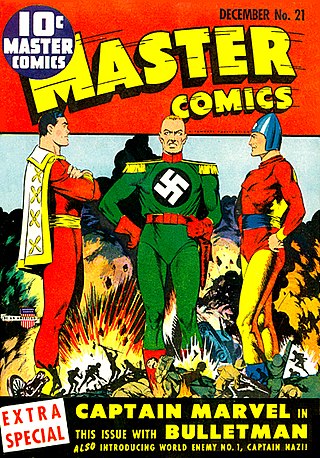
Captain Nazi is a Fawcett Comics and DC Comics supervillain, and rival of Captain Marvel and Captain Marvel Jr..
Superboy-Prime, also known as Superman-Prime or simply Prime, is a DC Comics superhero turned supervillain and an alternate version of Superman. The character first appeared in DC Comics Presents #87 and was created by Elliot S. Maggin and Curt Swan.

The Monster Society of Evil is a supervillain team created by Otto Binder and C. C. Beck for Fawcett Comics. It is led by Mister Mind against their mutual enemy Captain Marvel. The team is significant as one of the first supervillain teams in comics to contain villains that a superhero had fought previously; prior to this, supervillain teams were composed of villains created just for that storyline. In fact, the Monster Society consists of every major enemy Captain Marvel had ever faced.
Mister Atom is a fictional comic book supervillain, a radioactive robot who is regularly seen as an enemy of Captain Marvel. The character first appeared in Captain Marvel Adventures #78 in November 1947. Along with other members of Captain Marvel's rogues' gallery, Mister Atom was recruited by Mister Mind to be part of the second Monster Society of Evil in 1973.

Tawky Tawny is a fictional character, an anthropomorphic tiger who appears as a supporting character of Captain Marvel and the Marvel Family in superhero/talking animal comic book stories published by Fawcett Comics and later DC Comics.
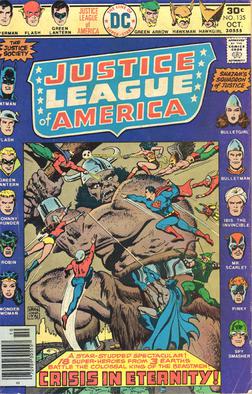
King Kull is a supervillain, created by Otto Binder and C.C. Beck. He originally appeared in Fawcett Comics in the early 1950s, before that company ceased publishing its superhero titles. DC Comics would later revive the character in the 1970s, where he now appears as a foe of Captain Marvel.
The Seven Deadly Enemies of Man, is the name of a group of fictional demon characters appearing in American comic books published by DC Comics. They debuted in Whiz Comics #2 and were created by C.C. Beck and Bill Parker.

Greg Saunders is a superhero appearing in American comic books published by DC Comics. He is the first DC character to bear the name Vigilante.
The Rock of Eternity is a fictional location appearing in American comic books featuring Captain Marvel / Shazam and/or his associated characters, first in publications by Fawcett Comics and later by DC Comics.
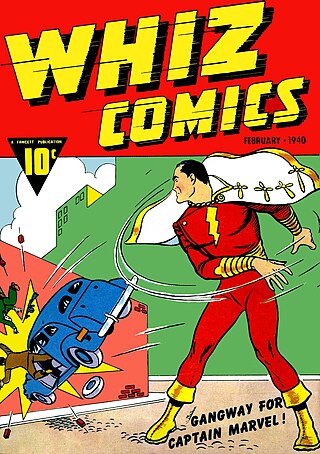
The 1940s were an essential time for DC Comics. Both National Comics Publications and All-American Publications would introduce many new featured superheroes in American comic books in superhero comics anthology tales like More Fun Comics, Adventure Comics, Detective Comics, Action Comics, All-American Comics, Superman, Flash Comics, Batman, All Star Comics, World's Finest Comics, All-Flash, Star Spangled Comics, Green Lantern, Leading Comics, Sensation Comics, Wonder Woman, Comic Cavalcade and Superboy that would be a staple for the comic book company. Examples of the superheroes include the Flash, Hawkman and Hawkgirl, Johnny Thunder and Thunderbolt, Spectre, Hourman, Robin, Doctor Fate, Congo Bill, Green Lantern, Atom, Manhunter, Doctor Mid-Nite, Sargon the Sorcerer, Starman, Johnny Quick, the Shining Knight, the Star-Spangled Kid and Stripesy, Tarantula, Vigilante, Green Arrow and Speedy, Aquaman, Wonder Woman, Sandy, the Golden Boy, Mister Terrific, Wildcat, Air Wave, Guardian, Robotman, TNT and Dan the Dyna-Mite, Liberty Belle, Superboy and Black Canary. These characters would later crossover in superhero team titles in the 1940s such as the Justice Society of America and the Seven Soldiers of Victory helping pave a way to a shared universe of the publication company. Other used featured characters outside of superheroes included kid titular heroes like the Newsboy Legion and the Boy Commandos. Later Western heroes would be used such as Johnny Thunder, Nighthawk and Pow Wow Smith.
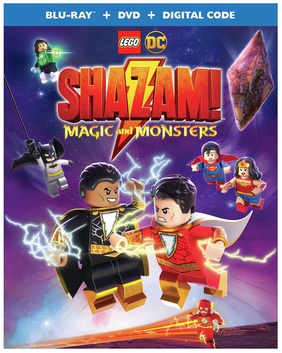
Lego DC Shazam!: Magic and Monsters is a 2020 American computer-animated superhero comedy film based on the DC Comics and Lego brands. The film is produced by DC Entertainment, The Lego Group and Warner Bros. Animation and distributed by Warner Bros. Home Entertainment. It is the tenth Lego DC Comics film and was released on digital on April 28, and on Blu-ray and DVD on June 16, 2020. The film received positive reviews from critics, with praise for the humor and action.
References
- ↑ Greenberger, Robert (2008). The Essential Batman Encyclopedia. Del Rey. pp. 105–106. ISBN 9780345501066.
- ↑ Leading Comics #1 (December 1941). DC Comics.
- ↑ Action Comics #58 (March 1943). DC Comics.
- ↑ Action Comics #63 (August 1943). DC Comics.
- ↑ Leading Comics #8 (September 1943). DC Comics.
- ↑ Action Comics #69 (February 1944). DC Comics.
- ↑ World's Finest #246. DC Comics.
- ↑ All-Star Squadron #51-54. DC Comics.
- ↑ Infinity Inc. #51-53. DC Comics.
- ↑ Vigilante: City Lights, Prairie Justice #4. DC Comics.
- ↑ Shazam (vol. 3) #10 (January 2020). DC Comics.
- ↑ Shazam (vol. 3) #11 (February 2020). DC Comics.
- ↑ Batman #134. DC Comics.
- ↑ Earth-Prime #4. DC Comics.